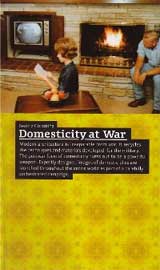 Domesticity at War (Amazon USA
Domesticity at War (Amazon USA

Editor Actar‘s blurb: In the postwar, cold war years, there emerges a new type of modern architecture that represents a fundamental transformation from only five decades prior. In Domesticity at War, Beatriz Colomina presents domesticity as a new, and very potent weapon in a changed architectural battlefield. No longer the domain of heroic figures, this post war architecture becomes the property of the middle-class consumer, a truly “modern manâ€? who is constantly bombarded with images of domestic bliss that form a lifestyle campaign, exactingly deployed using recycled military methods and techniques, launched into millions of homes. The resultant mass consumable environment transformed both architect and building, replacing them with newer versions, blindingly happy agents of domestic pleasure, at the same breakneck efficiency that marked the transition of wartime industry to peacetime, from missiles to washing machines. The significance of architects such as Charles and Ray Eames lies in their particular sensitivity to this transformation where buildings and images both come to define occupiable space. A sense of embattled domesticity is the trademark of the immediate postwar years and the focus of this archaeological study.
Turning the hard cover you discover that the book is divided in two units: one book for the text a few photos, and a smaller one containing only illustrations– including advertisements, newspaper and magazine articles, architectural photographs, etc. Charming idea, though it doesn’t make the reading very practical.
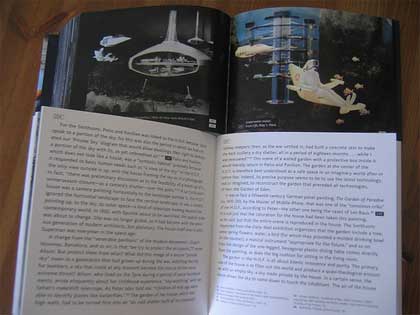
The European architecture avant-garde in the ’20s (in particular Le Corbusier) dreamt of mass-produced houses which would recycle the techniques and materials developed during WWI, but it was in the US that architecture really became was a by-product of the military-industrial complex, during the second half of the 20th Century. On the one hand the industry recycled products and techniques developed and tested at war, on the other hand, architects themselves had been involved in the development of military products.

For instance, Charles and Ray Eames‘s company designed and produced molded plywood splint for the US military. Devised to replace metal leg splint of wounded soldiers they were a success and by 1945, the company was issuing plywood cabinets, children furniture, chairs, tables, and even Christmas decoration from left-overs.
After 1945, war doesn’t simply disappear, not just because it is carried out in the form of the consumption of mass-produced spin-offs of military efficiency and technology but also because domestic life can no longer be taken for granted, it even becomes a form of art therapy for a traumatized nation. Colomina examines in particular the “Lawn at War.”
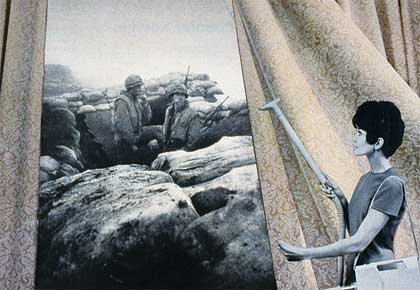 Cleaning The Drapes (from Bringing the War Home) by Martha Rosler, 1969-72
Cleaning The Drapes (from Bringing the War Home) by Martha Rosler, 1969-72
During WWII, maintaining a lawn is a national duty performed for the moral of both those who stayed home and the armed force. However, people are invited to dedicate part of the lawn to the Victory Garden. Gardening was also used as a therapy that helped healing hospital veterans. What is interesting is to see how advertising used war imagery and military rhetoric: the garden becomes a battlefield where, for example, beetles are compared to Japanese soldiers; a BugBlaster device is shaped like a bazooka, lawn mowers are advertised as weapons. In fact, the insecticide industry started as a spin-off of military research on chemical warfare during WWII. The most famous example of military use of insecticide being DDT, the “atomic bomb of the insect world.”
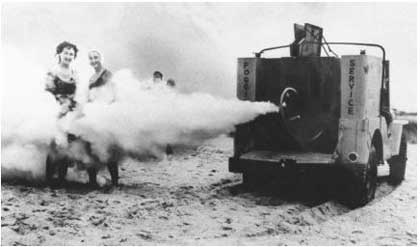 Before the dangers of DDT were known, crops & people alike were sprayed with the chemical to protect against bothersome insects
Before the dangers of DDT were known, crops & people alike were sprayed with the chemical to protect against bothersome insects
The author goes further when she explains that everything that made America in the ’50s was the result of military effort: cars, appliances, medicine, even fast food, etc.
Computers were the stars of the 1964 New York World’s Fair. Descendants of the first computers developed to decode enemy messages during WWII, these new computers were concerned with domestic issues, from helping out with the homeworks to helping you select the most suitable colour to decorate your home.
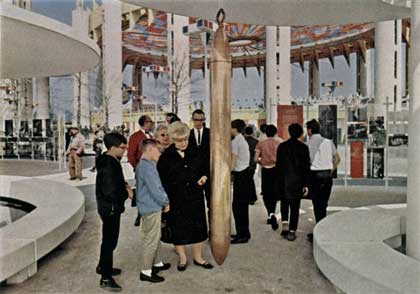 At the New York World’s Fair (image via)
At the New York World’s Fair (image via)
The mere fact of being affluent was regarded as a form of victory during the Cold War. Through the “battle of the appliances” the US wanted to create envy and establish their superiority over Russia. The so-called Kitchen Debate epitomized the notion when Nixon and Khrushchev discussed the respective merits of communism and capitalism while the US President was in Moscow and showing the Soviet Premier a model American home, “a vitrine of all-American perfection.”
However, the family fallout shelters popping up in American suburbia were singing a different story. It wasn’t a question of domestic bliss anymore, as the shelters were built in a climate of fear and schizophrenia (there are nice anecdotes in the book about proud owner of new shelters who devised ways to protect their new underground “wing” from their own neighbours).
 Melvin and Maria Mininson honeymooned in a Miami bomb shelter in June 1959. Chosen from over 100 couples, the newlyweds spent two encapsulated weeks as a publicity stunt sponsored by a shelter manufacturer
Melvin and Maria Mininson honeymooned in a Miami bomb shelter in June 1959. Chosen from over 100 couples, the newlyweds spent two encapsulated weeks as a publicity stunt sponsored by a shelter manufacturer
The most extraordinary example of nuclear shelter must be the one devised by Jay Swayze in 1962. This full-time underground home boasted windows throughout the house give you a false sense of being above ground. “Dial a view” murals on the concrete shell enabled the owner to change the panoramic landscape at will and to choose the best lighting according to time: daytime, dusk, nighttime, and dawn.
Real plants grow to artificial lights on the porch, and days and nights are always calm, despite what the weather may be doing 13 feet above ground. Images.
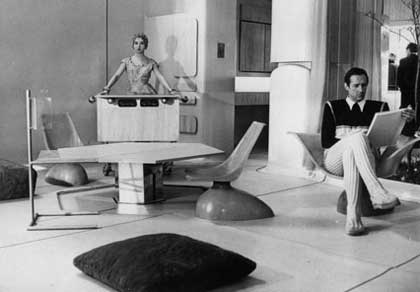 Alison and Peter Smithson‘s House of the Future displayed at the Ideal Home exhibition in 1956
Alison and Peter Smithson‘s House of the Future displayed at the Ideal Home exhibition in 1956
Although i was sometimes annoyed by Colomina’s eulogy of everything Eames and the fact that it wasn’t always clear what some of the stories she mentioned had to do with the title of the book, Domesticity at War is fantastically enjoyable. It is witty, clear, and choke-full of well-documented anecdotes and facts. You get to learn the story of the lawn and how it was used in advertisements, discover the plastic houses that came with built-in sewing machines, read how glass curtain walls were used to put domestic bliss on display, and why Buckminster Fuller‘s DDUs (Dymaxion Deployment Units) match all of Duchamp’s criteria for the perfect readymade, etc. 3 extra stars for the amazing collection of photos, they make the book worth buying on their own.
